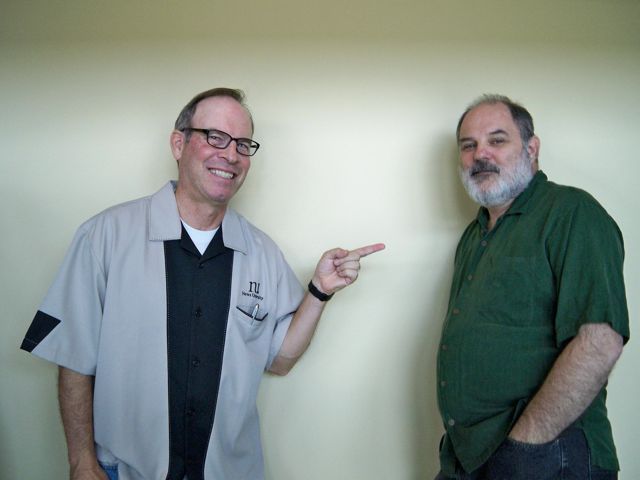Some of the best advice on writing I have ever received came from reading interviews with writers. Perhaps the greatest collection of these comes from decades of interviews in the Paris Review.
I still have in my mind an insight shared by Elie Wiesel, the great witness to the Holocaust. He described a process of exhaustive research for a book, then decided to leave out so much of what he had gathered. Why did he leave it out? He answered something like: Even though I chose not to use it, it’s still in there.
My Poynter pal Chip Scanlan and I have spent much of the last 30 years interviewing writers. We interview them to learn their process, to listen to their stories, to ask them open-ended questions that lead to clarity and focus. Even when a writer is interviewing me, I instinctively will ask them about their process or what else they are working on.
Chip is at it again, with a dutiful act of self-publication, a process I want to learn more about. (Chip wrote more about the self-publishing process for Poynter.) The book bears the title: “Writers on Writing: Inside the lives of 55 distinguished writers and editors,” and offers a surprising collection of answers to four questions about the craft.
As Chip got closer to publication, he asked me to write the foreword, which I was happy to do. He was on a deadline, so I wrote it quickly, which was my path, as usual, to some sweet surprises. (Check out my paragraph devoted to the word and name “Chip”!)
With Chip’s permission, Poynter is republishing my foreword. Think of it as a trailer for the movie version. As I am one of 55 writers featured in the book, we are also sharing my answers to the four great questions. Here’s a tip: If you belong to a writing group, or if you hang out now and then at the coffee shop with other scribes, as Chip’s four questions to each other. Enjoy what happens next.
Foreword
In 1977 I was hired as a writing coach for a newspaper then called the St. Petersburg Times. My tenure corresponded to an annual newspaper writing contest sponsored by the American Society of Newspaper Editors. My job was to curate the winning entries and comment on their virtues. I wanted to add one additional feature: an interview with each of the writers.
The editor who hired me wasn’t sure it was a good idea. He lacked confidence that the “ink-stained wretches,” as deadline reporters were called back in the day, were reflective enough about their work to offer useful and inspirational answers to questions about craft, confidence, and mission. Thirty years and 30 editions of “Best Newspaper Writing” later, that editor, Gene Patterson, laughed at his skepticism.
During those decades my greatest ally, my tag team partner, was a reporter, feature writer, investigator, novelist, author and teacher named Christopher Scanlan. We all called him Chip. The name turned out to be apt. He would chip away at a writing project. He would become a chip off the old block — a protégé of America’s greatest writing teacher Donald Murray, who taught us all how to demystify the process of writing in the public interest. With his almost compulsive need to understand the craft, he would share his new insights with readers everywhere as a Chip-on-our-shoulder, whispering into our ears like Jiminy Cricket. As a technological revolution took hold, he became Computer Chip, encouraging us not to fear, but to embrace the change.

Roy Peter Clark and Chip Scanlan at a farewell luncheon and ceremony for Bob Steele and his family on May 23, 2008, in St. Petersburg, Florida. (Omar Schwanzer/Poynter)
In January of 2020, a great visionary number, Little, Brown published my book “Murder Your Darlings.” It was my writing book about writing books, more than 50 of them “from Aristotle to Zinsser.” The book has not sold that well, but I am blaming that on the pandemic. I look forward to a new edition. I can’t wait to add Chip’s “Writers on Writing” to my list of essential texts.
A great writing teacher named Shirley Brice Heath once asked me to name the most literate people in America. I blurted “Susan Sontag and William F. Buckley Jr.” “OK, what makes them stand out as literate? What can they do better than the rest of us? And what do we have to do to become more literate?”
She was Socrates, and I was Young Clueless. She led me to the notion that literate people excel at three behaviors, things they practice almost every day: They read appreciatively. They write purposefully. And — here was the kicker — they thought and talked and wrote about how meaning is created by the written word. Read, write, talk.
By asking four questions to 55 of our finest writers, Chip Scanlan has hosted one of the greatest writing conferences you will ever attend. The answers from a rich variety of scribes reveal the complexity of the craft, with wide doors all of us can pass through on our way to growing as writers.
If you read this book twice, you will experience a fruitful journey. On the first reading, you will marvel at the individuality — even eccentricity — of the scribes. Hey, when asked to embrace a metaphor for my writing, I compared myself to a “nail technician.”
But please read it a second time. During that reprise you will hear the writers having to solve the same essential problems, a vision of writing at the heart of the teaching of our mentor Donald Murray. It matters not whether you are writing a haiku or a 29-part narrative series. You need to find an idea, something worth writing about. You need to collect — through research and reporting — much more than you think you need. You need a focus, a governing idea, the heart of the story. You can then use that focus to select the stuff you’ve gathered that best supports it, your best evidence. A shape for your text comes into view, sometimes early, sometimes late, helping sort out what belongs in the beginning, the middle, and the end. The right language finds us or we find it, through listening and through drafting. We learn to transform procrastination into rehearsal, to lower our standards at the beginning of a draft and to raise them through revision.
From 1977 to the current moment there has been a movement to improve the quality of writing, not just among journalists, but among all public writers. Chip Scanlan, who does not like sports, is an all-star on this team, a most valuable player, headed to the hall of fame.
My Answers to the Four Questions
What’s the biggest lesson you’ve learned as a writer?
I saw that Dan Barry said that a big lesson for him was that the process gets harder. That feels true. But for me the process has gotten easier. I am not Sisyphus kicking that stone downhill. But I feel that I am at least rolling it on a level plain. But it only gets easier if you are willing to relearn the big lessons with each project. I’m talking about books now. I’ve written six in 12 years. I have a process that I borrowed from Bill Howarth’s description of John McPhee.
I need my raw material, my index cards, my file folders, my bulletin board. If I try a shortcut, if I lean too heavily on my experience, if I try to dance over a step, I usually crash to the bottom of the staircase. Use the process. Follow the steps. Trust the process. You have to trust. Even if it’s not going well at this moment, keep at it. Realize that the imperfection you feel right now is necessary.
There was a great bowler from Texas named Billy Welu who used to be a color commentator for televised bowling tournaments. He would point out that some bowlers with big hooks needed to roll the ball at the edge of the gutter in order for it to curve into the pocket for a strike. “Trust is a must,” he would say in a Texas drawl, “or your game is a bust.”
What’s been the biggest surprise of your writing life?
My biggest surprise as a writer came when I was about 30 years old. It surprised me again when I was about 60 years old. This had to do with my personal and professional identity. That is, how I identified myself. I meet people all the time who say, “I’m not a writer, but I am working on a novel.” Or “I write reports at work all day, but I’m not saying I’m a writer.” I play rock and roll piano. And on occasion I hit a golf ball. I am not Jimi Hendrix or Tiger Woods, but I feel comfortable calling myself a musician and a golfer.
I was trained in graduate school to become a young English professor. And I wrote a Ph.D. dissertation about Chaucer, but I did not consider myself a writer. I became a newspaper writing coach, but did not call myself a writer. In 1979 I had about 250 bylines in the St. Petersburg Times. Finally, it hit me: “You know, Roy, maybe you could be a writer.” It feels crazy in retrospect: becoming a writing coach BEFORE I embraced the identity as a writer. Thirty years later, I could easily say I was a writer and a teacher of writing. Then it happened again. I wrote the book “Writing Tools” — followed by five more with Little, Brown. LB published Emily Dickinson! “Holy s***,” I thought, “I’m not just a writer — I’m an author!” If you write, you’re a writer. If you auth, you’re an author.
If you had to choose a metaphor to describe yourself as a writer, what would it be?
I am fascinated by the work of Phoukhoun Phimsthasak, a woman who made her way from Laos to America. She has an amazing personal story of escape, rescue, renewal, and hard, hard work. My wife and I know her as Jane. She does manicures and pedicures. As I metaphor, I can think of myself as a nail specialist. I work with an elaborate tool set, and a process that has a set of predictable steps, with some special challenges and surprises along the way. My mission relates to both utility and beauty, but also to listening and public service. It’s also about relationship building and referral, because there are a lot of nail specialists out there and many of them are good. But I want you to keep coming back to me.
What is the best piece of writing advice anyone ever gave you?
The best piece of writing advice I ever received came from — no surprise — Don Murray. He passed on to us the tools of clarity, how to make hard facts easier reading. This requires writers to use shorter words, shorter sentences, and shorter paragraphs at the points of greatest complexity. As a writer and teacher, I have put that advice into action countless times.







